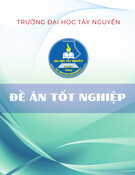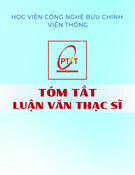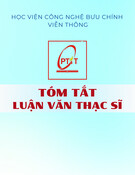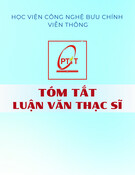
HỌC VIỆN KHOA HỌC VÀ CÔNG NGHỆ
……..….***…………
MINISTRY OF EDUCATION
AND TRAINING
VIETNAM ACADEMY OF
SCIENCE AND TECHNOLOGY
GRADUATE UNIVERSITY OF SCIENCE AND TECHNOLOGY
……..….***…………
NGUYEN THI PHUONG
PLANETARY FORMATION SEEN WITH ALMA: GAS AND
DUST PROPERTIES IN PROTOPLANETARY DISKS AROUND
YOUNG LOW-MASS STARS
Major: Atomic physics
Code: 9 44 01 06
SUBSTANTIAL SUMMARY
Hanoi – 2019

HỌC VIỆN KHOA HỌC VÀ CÔNG NGHỆ
……..….***…………
This thesis has been completed at Laboratory of Astrophysics of
Bordeaux, University of Bordeaux and Graduate University of Science
and Technology – Vietnam Academy of Science and Technology
Supervisors: 1. Dr. Pham Ngoc Diep – Vietnam National Space Center,
Vietnam Academy of Science and Technology
2. Dr. Anne Dutrey, Laboratory of Astrophysics of
Bordeaux, University of Bordeaux
Referees :
1. TS. Emmanuel Dartois – Institut des Sciences Moléculaires d’Orsay,
France
2. GS.TS. Hideko Nomura – National Astronomical Observatory of Japan
This thesis will be defended at Graduate University of Science and
Technology – Vietnam Academy of Science and Technology at 9h00,
November 22, 2019
This thesis can be found at:
- Library of Graduate University of Science and Technology
- National Library of Vietnam

List of publications
1. Phuong, N. T., Dutrey, A., Diep, P. N, Guilloteau, S.,
Chapillon, E., Di Folco, E., Tang, Y-W., Pietu, V., Bary, J.,
Beck, T. , Hersant , F., Hoai, D.T., Hure , J.M. , Nhung, P.T. ,
Pierens, A. , Tuan-Anh, P., GG Tau A: properties and
dynamics from the cavity to the outer disk, submitted to
A&A.
2. Phuong, N. T., Chapillon, E., Majumdar, L., Dutrey, A.,
Guilloteau, S., Piétu, V., Wakelam, V., Diep, P. N., Tang, Y.-
W., Beck, T., & Bary, J., First detection of H2S in a
protoplanetary disk. The dense GG Tauri A ring, A&A, 616,
L5, 2018.
3. Phuong, N. T., Diep, P. N., Dutrey, A., Chapillon, E.,
Darriulat, P., Guilloteau, S., Hoai, D. T., Tuyet Nhung, P.,
Tang, Y.-W., Thao, N. T., & Tuan-Anh, P., Morphology of
the 13CO(3
-
2) millimetre emission across the gas disc
surrounding the triple protostar GG Tau A using ALMA
observations, RAA, 18, 031, 2018.

Understanding how planetary systems form is a major
challenge of Astrophysics in the 21st century. For this pur-
pose, observing young low-mass stars, similar to the Sun when
it was in its infancy is a necessary step. Indeed, planets form
from the rotating disk of gas and dust orbiting around these
young stars (also called T Tauri stars). This disk is itself
a residual from the molecular cloud which has formed the
central star, and so called protoplanetary disk. As a con-
sequence, determining the physics and chemistry at play in
these protoplanetary disks has become an important domain
of the modern astrophysics requesting both detailed obser-
vations and sophisticated models. Thus constraining initial
conditions leading to planetary systems by making relevant
comparisons with planet formation models requests an obser-
vational evaluation of the physical properties (density, temper-
ature, turbulence, etc) and chemical evolution of the gas and
dust disks surrounding T Tauri stars. An important source
of complexity for the observations resides in the fact that
the determination of these fundamental physical parameters
is strongly degenerated within a single observation. The role
of the observer is therefore to define an observing strategy,
e.g. by observing several molecules, which allows an accurate
derivation of the physical properties by minimizing the impact
of possible degeneracies. Knowing the properties of the dust
(nature, size, morphology) is essential to understand the for-
1

mation of planetary embryos but also the genesis of complex
molecules. Many organic molecules form onto grain surfaces
where gaseous molecules freeze out as soon as the temperature
is cold enough (e.g. 17 K for CO) and interact with molecules
already trapped onto grains. This thesis investigates the prop-
erties of the protoplanetary disk surrounding a triple low-mass
stellar system, GG Tau A, using interferometric observations
of trace molecules such as 12CO, 13CO, C18O, DCO+, HCO+
and H2S, and of multi-wavelength dust emission.
Chapter 1 introduces the topic and the current knowledge
of protoplanetary disks. The special case of protoplanetary
disks surrounding binary systems is introduced both for the
theoretical studies and for the observations. The second part
of the Chapter presents the known properties on the GG Tau
A system.
Chapter 2 summarizes some basic points about instruments,
observations and analysis methods used in the present study.
It briefly introduces IRAM and ALMA interferometers, the
observations carried out with these facilities and data reduc-
tion. It also present the principles of radio interferometry and
deconvolution. It also recalls the bases of radiative transfer,
and a radiative transfer code (DiskFit) is introduced at the
end of the Chapter.
2














![Đề án Thạc sĩ: Tổ chức hoạt động văn hóa cho sinh viên Trường Cao đẳng Du lịch Hà Nội [Chuẩn nhất]](https://cdn.tailieu.vn/images/document/thumbnail/2025/20251202/kimphuong1001/135x160/91661764646353.jpg)











